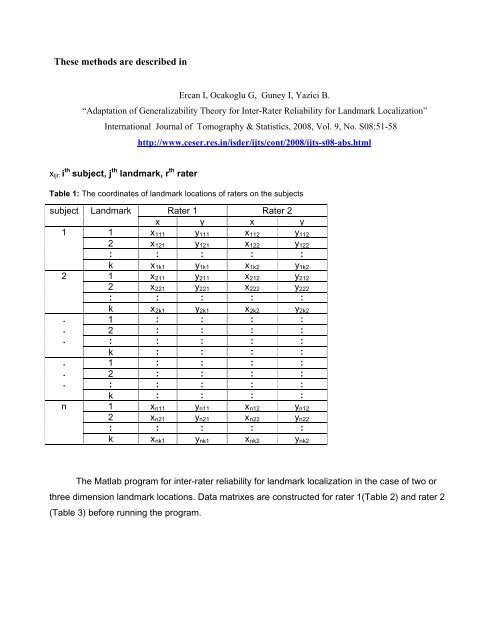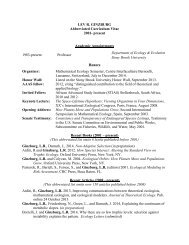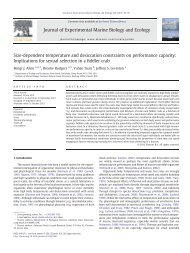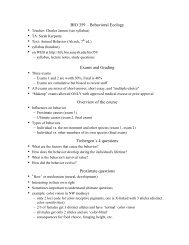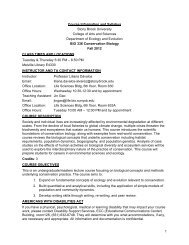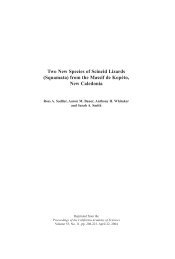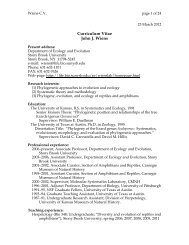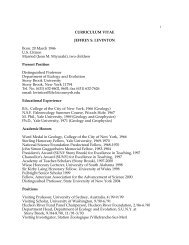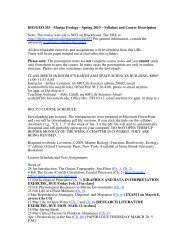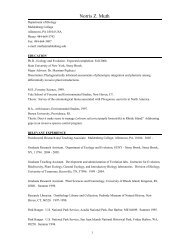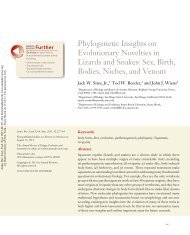matlab adaptation of generalizability theory for inter-rater reliability ...
matlab adaptation of generalizability theory for inter-rater reliability ...
matlab adaptation of generalizability theory for inter-rater reliability ...
Create successful ePaper yourself
Turn your PDF publications into a flip-book with our unique Google optimized e-Paper software.
These methods are described in<br />
Ercan I, Ocakoglu G, Guney I, Yazici B.<br />
“Adaptation <strong>of</strong> Generalizability Theory <strong>for</strong> Inter-Rater Reliability <strong>for</strong> Landmark Localization”<br />
HInternational Journal <strong>of</strong> Tomography & Statistics, 2008, Vol. 9, No. S08:51-58<br />
xijr: i th subject, j th landmark, r th <strong>rater</strong><br />
HUhttp://www.ceser.res.in/isder/ijts/cont/2008/ijts-s08-abs.htmlU<br />
Table 1: The coordinates <strong>of</strong> landmark locations <strong>of</strong> <strong>rater</strong>s on the subjects<br />
subject Landmark Rater 1 Rater 2<br />
x y x y<br />
1 1 x111 y111 x112 y112<br />
2 x121 y121 x122 y122<br />
: : : : :<br />
k x1k1 y1k1 x1k2 y1k2<br />
2 1 x211 y211 x212 y212<br />
2 x221 y221 x222 y222<br />
: : : : :<br />
k x2k1 y2k1 x2k2 y2k2<br />
. 1 : : : :<br />
. 2 : : : :<br />
. : : : : :<br />
k : : : :<br />
. 1 : : : :<br />
. 2 : : : :<br />
. : : : : :<br />
k : : : :<br />
n 1 xn11 yn11 xn12 yn12<br />
2 xn21 yn21 xn22 yn22<br />
: : : : :<br />
k xnk1 ynk1 xnk2 ynk2<br />
The Matlab program <strong>for</strong> <strong>inter</strong>-<strong>rater</strong> <strong>reliability</strong> <strong>for</strong> landmark localization in the case <strong>of</strong> two or<br />
three dimension landmark locations. Data matrixes are constructed <strong>for</strong> <strong>rater</strong> 1(Table 2) and <strong>rater</strong> 2<br />
(Table 3) be<strong>for</strong>e running the program.
Table 2: Data matrix with name A is constructed <strong>for</strong> Rater 1 as follows <strong>for</strong> our example<br />
x111<br />
x121<br />
y111<br />
y121<br />
: :<br />
x1k1<br />
x211<br />
x221<br />
y1k1<br />
y211<br />
y221<br />
: :<br />
x2k1<br />
y2k1<br />
: :<br />
: :<br />
: :<br />
: :<br />
: :<br />
: :<br />
: :<br />
: :<br />
xn11<br />
xn21<br />
yn11<br />
yn21<br />
: :<br />
xnk1<br />
ynk1<br />
Table 3: Data matrix with name B is constructed <strong>for</strong> Rater 2 as follows <strong>for</strong> our example<br />
x112<br />
x122<br />
y112<br />
y122<br />
: :<br />
x1k2<br />
x212<br />
x222<br />
y1k2<br />
y212<br />
y222<br />
: :<br />
x2k2<br />
y2k2<br />
: :<br />
: :<br />
: :<br />
: :<br />
: :<br />
: :<br />
: :<br />
: :<br />
xn12<br />
xn22<br />
yn12<br />
yn22<br />
: :<br />
xnk2<br />
ynk2
After constructing the data matrixes the following program is run:<br />
% <strong>adaptation</strong> <strong>of</strong> <strong>generalizability</strong> <strong>theory</strong> <strong>for</strong> <strong>inter</strong>-<strong>rater</strong><br />
% <strong>reliability</strong> <strong>for</strong> landmark localization<br />
% <strong>for</strong> 2 or 3 dimensions<br />
ENTRIES={'NUMBER OF DIMENSION','NUMBER OF SUBJECTS','NUMBER OF LANDMARKS'};<br />
baslangic={'','',''};<br />
window='PLEASE INPUT ';<br />
INPUTS=inputdlg(ENTRIES,window,1)<br />
db=str2num(char(INPUTS(1,1)))<br />
n=str2num(char(INPUTS(2,1)))<br />
k=str2num(char(INPUTS(3,1)))<br />
a=0; rr=0; ka=0; kb=0; sn1=1; tlsr=0; tlr2=0; tr2=0; tr1a=0; tr1b=0;<br />
tl2=0; ts2=0; tlsb2=0; td=0; tlre=0; tsre=0; sn2=0; d=0; trs2=0; srkt=0;<br />
C = nchoosek(k,2); sn2=(n*(C)); s=C*n<br />
%Constructing coding matrix <strong>for</strong> (R) landmark pair(l) x <strong>rater</strong>(r) x subject(s)<br />
<strong>for</strong> a=1:2<br />
end<br />
<strong>for</strong> b=1:n<br />
end<br />
<strong>for</strong> c=1:C<br />
end<br />
d=d+1; R(d,1)=a; R(d,2)=b; R(d,3)=c;<br />
% Reading the matrixes A and B <strong>for</strong> <strong>rater</strong> 1 and Rater 2<br />
<strong>for</strong> i=1:(n*k)<br />
end<br />
<strong>for</strong> j=1:db<br />
A(i,j)<br />
B(i,j)<br />
end<br />
%Calculation <strong>of</strong> the Euclidean distances between landmark pairs <strong>for</strong> <strong>rater</strong>s<br />
if (db
<strong>for</strong> p=1:k:(n*k)<br />
t=k+p; m=t-k;<br />
<strong>for</strong> j=m:(t-1)<br />
<strong>for</strong> i=m:(t-1)<br />
if (j
% calculation <strong>of</strong> sum <strong>of</strong> squares <strong>for</strong> r (cont. Outside the loop)<br />
tr1a=tr1a+acia1; tr1b=tr1b+acib1;<br />
% calculation <strong>of</strong> adjustment factor (cont. Outside the loop)<br />
end<br />
end<br />
end<br />
td=td+acia1+acib1;<br />
sn1=sn1+1;<br />
end<br />
end<br />
% calculation <strong>of</strong> adjustment factor<br />
df=(td^2)/(2*C*n)<br />
% calculation <strong>of</strong> sum <strong>of</strong> square <strong>of</strong> r and mean <strong>of</strong> square <strong>of</strong> r<br />
tr2=(tr1a^2)+(tr1b^2); rkt=(tr2/(C*n))-df; rko=((tr2/(C*n))-df)/1; ms_r=rko;<br />
% Division <strong>of</strong> R matrix into 2 parts <strong>for</strong> analysis (P <strong>for</strong> <strong>rater</strong> 1, V <strong>for</strong> <strong>rater</strong> 2)<br />
<strong>for</strong> i=1:s<br />
end<br />
v=0;<br />
<strong>for</strong> j=1:4<br />
P(i,j)=R(i,j);<br />
end<br />
<strong>for</strong> i=(s+1):(2*s)<br />
v=v+1;<br />
<strong>for</strong> j=1:4<br />
V(v,j)=R(i,j);<br />
end<br />
end<br />
% calculation <strong>of</strong> sum <strong>of</strong> squares <strong>for</strong> l<br />
<strong>for</strong> l=1:C<br />
tl1=0;<br />
<strong>for</strong> i=1:s<br />
if (l>(P(i,3)-1)) & (l
end<br />
end<br />
if (l>(V(i,3)-1)) & (l(P(i,2)-1)) & (sb(V(i,2)-1)) & (sb(P(i,3)-1)) & (l(P(i,2)-1)) & (sb(V(i,3)-1)) & (l
end<br />
end<br />
if (sb>(V(i,2)-1)) & (sb(P(i,3)-1)) & (l(P(i,1)-1)) & (r(P(i,2)-1)) & (sb(V(i,1)-1)) & (r(V(i,2)-1)) & (sb
end<br />
end<br />
end<br />
end<br />
end<br />
trsv=trsv+V(i,4);<br />
trs2=trs2+(trsp^2)+(trsv^2);<br />
srkt=(trs2/C)-df-rkt-skt;<br />
% calculation <strong>of</strong> sum <strong>of</strong> squares <strong>for</strong> lxrxs<br />
tlsrkt=tlsr-df-lkt-rkt-skt-lrkt-lskt-srkt<br />
% calculation <strong>of</strong> Mean Squares<br />
ms_lrs=tlsrkt/((n-1)*(C-1));<br />
ms_lr=lrkt/(C-1);<br />
ms_ls=lskt/((n-1)*(C-1));<br />
ms_rs=srkt/(n-1);<br />
ms_l=lkt/(C-1);<br />
ms_s=skt/(n-1);<br />
% estimates <strong>of</strong> the variance components<br />
var_lrs=ms_lrs;<br />
var_lr=(ms_lr-ms_lrs)/n;<br />
var_ls=(ms_ls-ms_lrs)/2;<br />
var_rs=(ms_rs-ms_lrs)/C;<br />
var_l=(ms_l-ms_lr-ms_ls+ms_lrs)/(2*n);<br />
var_r=(ms_r-ms_lr-ms_rs+ms_lrs)/(C*n);<br />
var_s=(ms_s-ms_ls-ms_rs+ms_lrs)/(2*C);<br />
if (var_lrs
end<br />
if (var_rs
display('variance <strong>of</strong> l'), var_l<br />
display('variance <strong>of</strong> s'), var_s<br />
display('variance <strong>of</strong> lxs'), var_ls<br />
display('variance <strong>of</strong> lxr'), var_lr<br />
display('variance <strong>of</strong> rxs'), var_rs<br />
display('variance <strong>of</strong> lxrxs'), var_lrs<br />
display('variance <strong>of</strong> rel'), var_rel<br />
helpdlg(num2str(G),'G COEFFICIENT')


